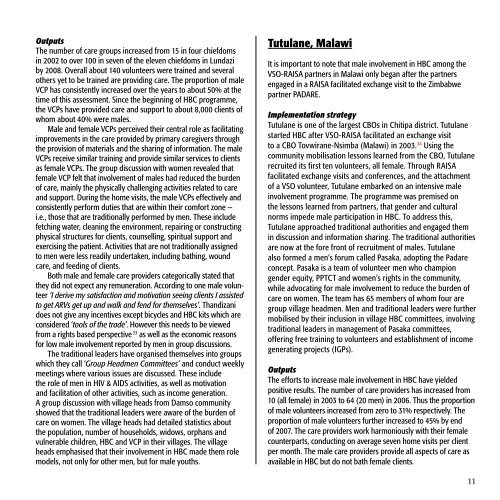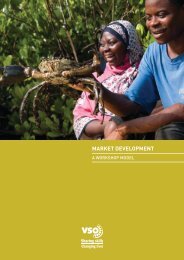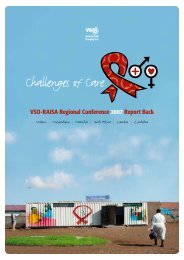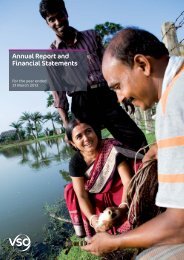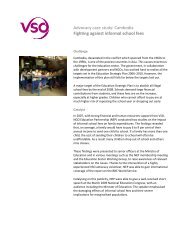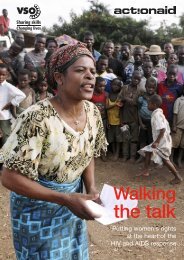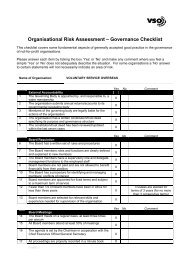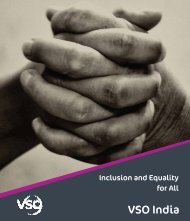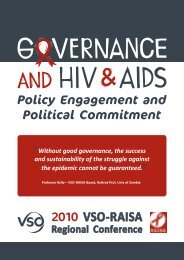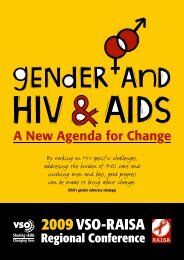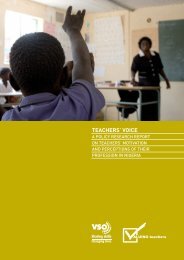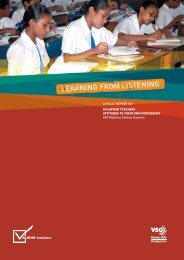Increased Male Involvement in Home-based Care to Reduce ... - VSO
Increased Male Involvement in Home-based Care to Reduce ... - VSO
Increased Male Involvement in Home-based Care to Reduce ... - VSO
- No tags were found...
Create successful ePaper yourself
Turn your PDF publications into a flip-book with our unique Google optimized e-Paper software.
OutputsThe number of care groups <strong>in</strong>creased from 15 <strong>in</strong> four chiefdoms<strong>in</strong> 2002 <strong>to</strong> over 100 <strong>in</strong> seven of the eleven chiefdoms <strong>in</strong> Lundaziby 2008. Overall about 140 volunteers were tra<strong>in</strong>ed and severalothers yet <strong>to</strong> be tra<strong>in</strong>ed are provid<strong>in</strong>g care. The proportion of maleVCP has consistently <strong>in</strong>creased over the years <strong>to</strong> about 50% at thetime of this assessment. S<strong>in</strong>ce the beg<strong>in</strong>n<strong>in</strong>g of HBC programme,the VCPs have provided care and support <strong>to</strong> about 8,000 clients ofwhom about 40% were males.<strong>Male</strong> and female VCPs perceived their central role as facilitat<strong>in</strong>gimprovements <strong>in</strong> the care provided by primary caregivers throughthe provision of materials and the shar<strong>in</strong>g of <strong>in</strong>formation. The maleVCPs receive similar tra<strong>in</strong><strong>in</strong>g and provide similar services <strong>to</strong> clientsas female VCPs. The group discussion with women revealed thatfemale VCP felt that <strong>in</strong>volvement of males had reduced the burdenof care, ma<strong>in</strong>ly the physically challeng<strong>in</strong>g activities related <strong>to</strong> careand support. Dur<strong>in</strong>g the home visits, the male VCPs effectively andconsistently perform duties that are with<strong>in</strong> their comfort zone —i.e., those that are traditionally performed by men. These <strong>in</strong>cludefetch<strong>in</strong>g water, clean<strong>in</strong>g the environment, repair<strong>in</strong>g or construct<strong>in</strong>gphysical structures for clients, counsell<strong>in</strong>g, spiritual support andexercis<strong>in</strong>g the patient. Activities that are not traditionally assigned<strong>to</strong> men were less readily undertaken, <strong>in</strong>clud<strong>in</strong>g bath<strong>in</strong>g, woundcare, and feed<strong>in</strong>g of clients.Both male and female care providers categorically stated thatthey did not expect any remuneration. Accord<strong>in</strong>g <strong>to</strong> one male volunteer‘I derive my satisfaction and motivation see<strong>in</strong>g clients I assisted<strong>to</strong> get ARVs get up and walk and fend for themselves’. Thandizanidoes not give any <strong>in</strong>centives except bicycles and HBC kits which areconsidered ‘<strong>to</strong>ols of the trade’. However this needs <strong>to</strong> be viewedfrom a rights <strong>based</strong> perspective 33 as well as the economic reasonsfor low male <strong>in</strong>volvement reported by men <strong>in</strong> group discussions.The traditional leaders have organised themselves <strong>in</strong><strong>to</strong> groupswhich they call ‘Group Headmen Committees’ and conduct weeklymeet<strong>in</strong>gs where various issues are discussed. These <strong>in</strong>cludethe role of men <strong>in</strong> HIV & AIDS activities, as well as motivationand facilitation of other activities, such as <strong>in</strong>come generation.A group discussion with village heads from Damso communityshowed that the traditional leaders were aware of the burden ofcare on women. The village heads had detailed statistics aboutthe population, number of households, widows, orphans andvulnerable children, HBC and VCP <strong>in</strong> their villages. The villageheads emphasised that their <strong>in</strong>volvement <strong>in</strong> HBC made them rolemodels, not only for other men, but for male youths.Tutulane, MalawiIt is important <strong>to</strong> note that male <strong>in</strong>volvement <strong>in</strong> HBC among the<strong>VSO</strong>-RAISA partners <strong>in</strong> Malawi only began after the partnersengaged <strong>in</strong> a RAISA facilitated exchange visit <strong>to</strong> the Zimbabwepartner PADARE.Implementation strategyTutulane is one of the largest CBOs <strong>in</strong> Chitipa district. Tutulanestarted HBC after <strong>VSO</strong>-RAISA facilitated an exchange visit<strong>to</strong> a CBO Tovwirane-Nsimba (Malawi) <strong>in</strong> 2003. 34 Us<strong>in</strong>g thecommunity mobilisation lessons learned from the CBO, Tutulanerecruited its first ten volunteers, all female. Through RAISAfacilitated exchange visits and conferences, and the attachmen<strong>to</strong>f a <strong>VSO</strong> volunteer, Tutulane embarked on an <strong>in</strong>tensive male<strong>in</strong>volvement programme. The programme was premised onthe lessons learned from partners, that gender and culturalnorms impede male participation <strong>in</strong> HBC. To address this,Tutulane approached traditional authorities and engaged them<strong>in</strong> discussion and <strong>in</strong>formation shar<strong>in</strong>g. The traditional authoritiesare now at the fore front of recruitment of males. Tutulanealso formed a men’s forum called Pasaka, adopt<strong>in</strong>g the Padareconcept. Pasaka is a team of volunteer men who championgender equity, PPTCT and women’s rights <strong>in</strong> the community,while advocat<strong>in</strong>g for male <strong>in</strong>volvement <strong>to</strong> reduce the burden ofcare on women. The team has 65 members of whom four aregroup village headmen. Men and traditional leaders were furthermobilised by their <strong>in</strong>clusion <strong>in</strong> village HBC committees, <strong>in</strong>volv<strong>in</strong>gtraditional leaders <strong>in</strong> management of Pasaka committees,offer<strong>in</strong>g free tra<strong>in</strong><strong>in</strong>g <strong>to</strong> volunteers and establishment of <strong>in</strong>comegenerat<strong>in</strong>g projects (IGPs).OutputsThe efforts <strong>to</strong> <strong>in</strong>crease male <strong>in</strong>volvement <strong>in</strong> HBC have yieldedpositive results. The number of care providers has <strong>in</strong>creased from10 (all female) <strong>in</strong> 2003 <strong>to</strong> 64 (20 men) <strong>in</strong> 2006. Thus the proportionof male volunteers <strong>in</strong>creased from zero <strong>to</strong> 31% respectively. Theproportion of male volunteers further <strong>in</strong>creased <strong>to</strong> 45% by endof 2007. The care providers work harmoniously with their femalecounterparts, conduct<strong>in</strong>g on average seven home visits per clientper month. The male care providers provide all aspects of care asavailable <strong>in</strong> HBC but do not bath female clients.11


